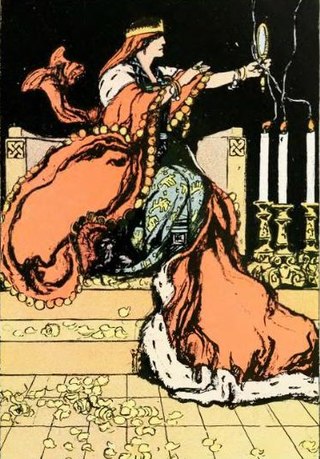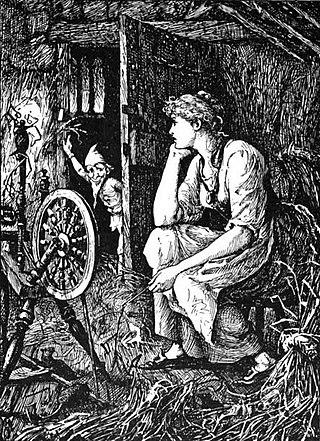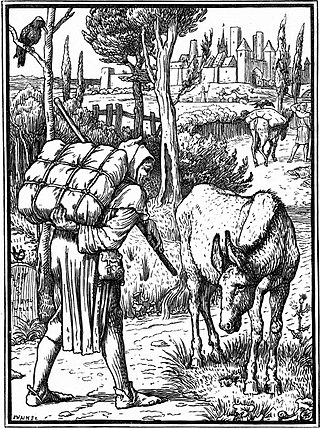
Andrew Lang was a Scottish poet, novelist, literary critic, and contributor to the field of anthropology. He is best known as a collector of folk and fairy tales. The Andrew Lang lectures at the University of St Andrews are named after him.

"Sleeping Beauty", also titled in English as The Sleeping Beauty in the Woods, is a fairy tale about a princess cursed by an evil fairy to sleep for a hundred years before being awakened by a handsome prince. A good fairy, knowing the princess would be frightened if alone when she wakes, uses her wand to put every living person and animal in the palace and forest asleep, to awaken when the princess does.

"Bluebeard" is a French folktale, the most famous surviving version of which was written by Charles Perrault and first published by Barbin in Paris in 1697 in Histoires ou contes du temps passé. The tale tells the story of a wealthy man in the habit of murdering his wives and the attempts of the present one to avoid the fate of her predecessors. "The White Dove", "The Robber Bridegroom" and "Fitcher's Bird" are tales similar to "Bluebeard". The notoriety of the tale is such that Merriam-Webster gives the word "Bluebeard" the definition of "a man who marries and kills one wife after another". The verb "bluebearding" has even appeared as a way to describe the crime of either killing a series of women, or seducing and abandoning a series of women.

The Evil Queen, also called the Wicked Queen or just the Queen, is a fictional character and the main antagonist of "Snow White", a German fairy tale recorded by the Brothers Grimm; similar stories exist worldwide. Other versions of the Queen appear in subsequent adaptations and continuations of the fairy tale, including novels and films. One particularly notable version is Disney's depiction, sometimes known as Queen Grimhilde. The character has also become an archetype that inspired unrelated works.

Mary Louisa Molesworth, néeStewart was an English writer of children's stories who wrote for children under the name of Mrs Molesworth. Her first novels, for adult readers, Lover and Husband (1869) to Cicely (1874), appeared under the pseudonym of Ennis Graham. Her name occasionally appears in print as M. L. S. Molesworth.

The Enchanted Castle is a children's fantasy novel by Edith Nesbit first published in 1907.

The Langs' Fairy Books are a series of 25 collections of true and fictional stories for children published between 1889 and 1913 by Andrew Lang and his wife, Leonora Blanche Alleyne. The best known books of the series are the 12 collections of fairy tales also known as Andrew Lang's "Coloured" Fairy Books or Andrew Lang's Fairy Books of Many Colors. In all, the volumes feature 798 stories, besides the 153 poems in The Blue Poetry Book.
Ruth Manning-Sanders was an English poet and author born in Wales, known for a series of children's books for which she collected and related fairy tales worldwide. She published over 90 books in her lifetime

The Wizard King is a French fairy tale published in Les fees illustres by the Chevalier de Mailly. Andrew Lang included it in The Yellow Fairy Book.

American Fairy Tales is the title of a collection of twelve fantasy stories by L. Frank Baum, published in 1901 by the George M. Hill Company, the firm that issued The Wonderful Wizard of Oz the previous year. The cover, title page, and page borders were designed by Ralph Fletcher Seymour; each story was furnished with two full-page black-and-white illustrations, by either Harry Kennedy, Ike Morgan, or Norman P. Hall.
Bearskin is a French literary fairy tale by Marie-Madeleine de Lubert. It was included in her revised edition, published in 1753, of Henriette-Julie de Murat's last novel, Les Lutins du château de Kernosy, which is why it is often attributed to Madame Henriette-Julie de Murat.
Mary De Morgan was an English writer and the author of three volumes of fairytales: On a Pincushion (1877); The Necklace of Princess Fiorimonde (1880); and The Windfairies (1900). These volumes appeared together in the collection The Necklace of Princess Fiorimonde – The Complete Fairy Stories of Mary De Morgan, published by Victor Gollancz Ltd in 1963, with an introduction by Roger Lancelyn Green.

"The Hundredth Princess" is a short fairy tale for children written by Evelyn Sharp. This fairy tale is among a collection of other short stories included in Evelyn Sharp's book titled The Other Side of the Sun (1900), which she wrote, published by John Lane.
"The Three Clever Kings" is a children's fairy tale from the anthology The Necklace of Princess Fiorimonde that was written by Mary De Morgan. The story was illustrated by Walter Crane, first published by MacMillan & CO. in 1886, and later published in a collection called The Necklace of Princess Fiorimonde – The Complete Fairy Stories of Mary De Morgan by Victor Gollancz Limited in 1963. This collection of fairy tales was digitized in July 2006 and the first E-book was released February 25, 2012. The E-book was produced by David Edwards, Josephine Paolucci, the Online Distributed Proofreading Team, and edited by The Project Gutenberg E-book.
Evelyn's Sharp's short story "The Wonderful Toymaker" is part of a collection of fairy tales in the book, All the Way to Fairyland: Fairy Stories. The Cambridge University Press originally published the anthology in 1897. An EBook version was made available through The Project Gutenberg on 3 November 2009.
"The Necklace of Princess Fiorimonde" is a fairy tale written by Mary De Morgan (1850–1907) in her collection of short stories called "The Necklace of Princess Fiorimonde and Other Stories." This collection of fairy tales originally published in 1880. Mary de Morgan helped to make the Victorian era prominent in literature. In her short stories, she is able to use "mystery, pathos, and comedy" to create entertaining and imaginative literature for all to enjoy. In addition, de Morgan uses both female and male protagonists in her writing exhibiting her belief in equality among the sexes. In many of her works, Mary de Morgan uses elements from the folk tales of medieval England. This is apparent in the universality of her literature, as it was easily relatable to all in Victorian England despite the different socioeconomic classes.

Published in 1886, "The Pedlar's Pack" is a fairy tale written by Mary De Morgan (1850–1907). The protagonist is a traveller and salesman who meets three animals on his journey to a nearby town; the story concludes with the four travellers bitterly vowing to never trust one another again.

"The Wise Princess” is a British fairy tale about a princess who knows everything, except for true happiness. It was written in the second half of the nineteenth century by Mary De Morgan. The tale first appeared in “The Tale of Princess Fiorimonde and Other Stories” along with six other tales, published by Macmillan and Co. in 1886.

"The Professor of Practical Jokes" is a literary fairy tale published in 1898 by British suffragist and author Evelyn Sharp (1829–1955). The story tells of a good yet boring king who is tricked into marrying one of his courtiers daughters, who brings excitement into his dull kingdom. The story is one of many published in Sharp's collection, All The Way To Fairyland: Fairy Stories.













